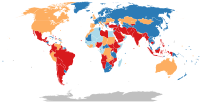
Photo from wikipedia
Soon after SARS-CoV-2 emerged in late 2019, Belgium was confronted with a first COVID-19 wave in March-April 2020. SARS-CoV-2 circulation declined in the summer months (late May to early July… Click to show full abstract
Soon after SARS-CoV-2 emerged in late 2019, Belgium was confronted with a first COVID-19 wave in March-April 2020. SARS-CoV-2 circulation declined in the summer months (late May to early July 2020). Following a successfully trumped late July-August peak, COVID-19 incidence fell slightly, to then enter two successive phases of rapid incline: in the first half of September, and then again in October 2020. The first of these coincided with the peak period of returning summer travelers; the second one coincided with the start of higher education’s academic year. The largest observed COVID-19 incidence occurred in the period 16–31 October, particularly in the Walloon Region, the southern, French-speaking part of Belgium. We examine the potential association of the higher education population with spatio-temporal spread of COVID-19, using Bayesian spatial Poisson models for confirmed test cases, accounting for socio-demographic heterogeneity in the population. We find a significant association between the number of COVID-19 cases in the age groups 18–29 years and 30–39 years and the size of the higher education student population at the municipality level. These results can be useful towards COVID-19 mitigation strategies, particularly in areas where virus transmission from higher education students into the broader community could exacerbate morbidity and mortality of COVID-19 among populations with prevalent underlying conditions associated with more severe outcomes following infection.
Journal Title: PLoS ONE
Year Published: 2022
Link to full text (if available)
Share on Social Media: Sign Up to like & get
recommendations!